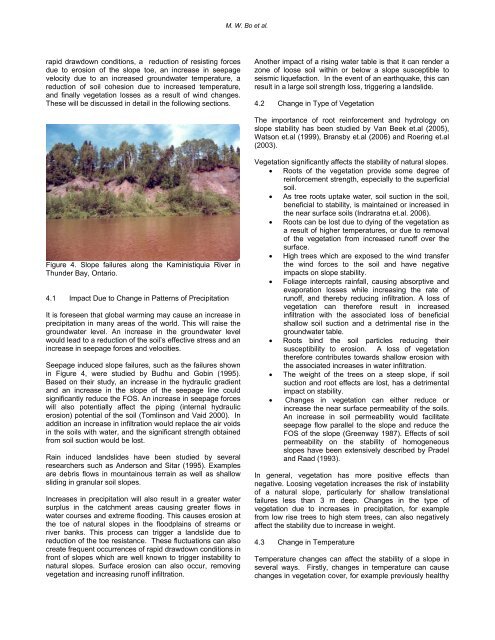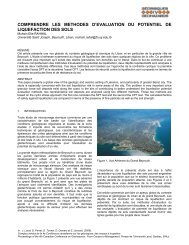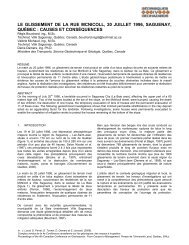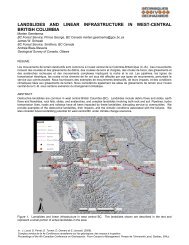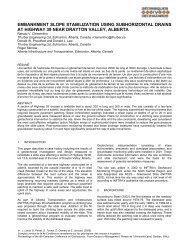Impact of global warming on stability of natural slopes
Impact of global warming on stability of natural slopes
Impact of global warming on stability of natural slopes
You also want an ePaper? Increase the reach of your titles
YUMPU automatically turns print PDFs into web optimized ePapers that Google loves.
M. W. Bo et al.<br />
rapid drawdown c<strong>on</strong>diti<strong>on</strong>s, a reducti<strong>on</strong> <str<strong>on</strong>g>of</str<strong>on</strong>g> resisting forces<br />
due to erosi<strong>on</strong> <str<strong>on</strong>g>of</str<strong>on</strong>g> the slope toe, an increase in seepage<br />
velocity due to an increased groundwater temperature, a<br />
reducti<strong>on</strong> <str<strong>on</strong>g>of</str<strong>on</strong>g> soil cohesi<strong>on</strong> due to increased temperature,<br />
and finally vegetati<strong>on</strong> losses as a result <str<strong>on</strong>g>of</str<strong>on</strong>g> wind changes.<br />
These will be discussed in detail in the following secti<strong>on</strong>s.<br />
Another impact <str<strong>on</strong>g>of</str<strong>on</strong>g> a rising water table is that it can render a<br />
z<strong>on</strong>e <str<strong>on</strong>g>of</str<strong>on</strong>g> loose soil within or below a slope susceptible to<br />
seismic liquefacti<strong>on</strong>. In the event <str<strong>on</strong>g>of</str<strong>on</strong>g> an earthquake, this can<br />
result in a large soil strength loss, triggering a landslide.<br />
4.2 Change in Type <str<strong>on</strong>g>of</str<strong>on</strong>g> Vegetati<strong>on</strong><br />
The importance <str<strong>on</strong>g>of</str<strong>on</strong>g> root reinforcement and hydrology <strong>on</strong><br />
slope <strong>stability</strong> has been studied by Van Beek et.al (2005),<br />
Wats<strong>on</strong> et.al (1999), Bransby et.al (2006) and Roering et.al<br />
(2003).<br />
Figure 4. Slope failures al<strong>on</strong>g the Kaministiquia River in<br />
Thunder Bay, Ontario.<br />
4.1 <str<strong>on</strong>g>Impact</str<strong>on</strong>g> Due to Change in Patterns <str<strong>on</strong>g>of</str<strong>on</strong>g> Precipitati<strong>on</strong><br />
It is foreseen that <str<strong>on</strong>g>global</str<strong>on</strong>g> <str<strong>on</strong>g>warming</str<strong>on</strong>g> may cause an increase in<br />
precipitati<strong>on</strong> in many areas <str<strong>on</strong>g>of</str<strong>on</strong>g> the world. This will raise the<br />
groundwater level. An increase in the groundwater level<br />
would lead to a reducti<strong>on</strong> <str<strong>on</strong>g>of</str<strong>on</strong>g> the soil’s effective stress and an<br />
increase in seepage forces and velocities.<br />
Seepage induced slope failures, such as the failures shown<br />
in Figure 4, were studied by Budhu and Gobin (1995).<br />
Based <strong>on</strong> their study, an increase in the hydraulic gradient<br />
and an increase in the slope <str<strong>on</strong>g>of</str<strong>on</strong>g> the seepage line could<br />
significantly reduce the FOS. An increase in seepage forces<br />
will also potentially affect the piping (internal hydraulic<br />
erosi<strong>on</strong>) potential <str<strong>on</strong>g>of</str<strong>on</strong>g> the soil (Tomlins<strong>on</strong> and Vaid 2000). In<br />
additi<strong>on</strong> an increase in infiltrati<strong>on</strong> would replace the air voids<br />
in the soils with water, and the significant strength obtained<br />
from soil sucti<strong>on</strong> would be lost.<br />
Rain induced landslides have been studied by several<br />
researchers such as Anders<strong>on</strong> and Sitar (1995). Examples<br />
are debris flows in mountainous terrain as well as shallow<br />
sliding in granular soil <strong>slopes</strong>.<br />
Increases in precipitati<strong>on</strong> will also result in a greater water<br />
surplus in the catchment areas causing greater flows in<br />
water courses and extreme flooding. This causes erosi<strong>on</strong> at<br />
the toe <str<strong>on</strong>g>of</str<strong>on</strong>g> <strong>natural</strong> <strong>slopes</strong> in the floodplains <str<strong>on</strong>g>of</str<strong>on</strong>g> streams or<br />
river banks. This process can trigger a landslide due to<br />
reducti<strong>on</strong> <str<strong>on</strong>g>of</str<strong>on</strong>g> the toe resistance. These fluctuati<strong>on</strong>s can also<br />
create frequent occurrences <str<strong>on</strong>g>of</str<strong>on</strong>g> rapid drawdown c<strong>on</strong>diti<strong>on</strong>s in<br />
fr<strong>on</strong>t <str<strong>on</strong>g>of</str<strong>on</strong>g> <strong>slopes</strong> which are well known to trigger in<strong>stability</strong> to<br />
<strong>natural</strong> <strong>slopes</strong>. Surface erosi<strong>on</strong> can also occur, removing<br />
vegetati<strong>on</strong> and increasing run<str<strong>on</strong>g>of</str<strong>on</strong>g>f infiltrati<strong>on</strong>.<br />
Vegetati<strong>on</strong> significantly affects the <strong>stability</strong> <str<strong>on</strong>g>of</str<strong>on</strong>g> <strong>natural</strong> <strong>slopes</strong>.<br />
• Roots <str<strong>on</strong>g>of</str<strong>on</strong>g> the vegetati<strong>on</strong> provide some degree <str<strong>on</strong>g>of</str<strong>on</strong>g><br />
reinforcement strength, especially to the superficial<br />
soil.<br />
• As tree roots uptake water, soil sucti<strong>on</strong> in the soil,<br />
beneficial to <strong>stability</strong>, is maintained or increased in<br />
the near surface soils (Indraratna et.al. 2006).<br />
• Roots can be lost due to dying <str<strong>on</strong>g>of</str<strong>on</strong>g> the vegetati<strong>on</strong> as<br />
a result <str<strong>on</strong>g>of</str<strong>on</strong>g> higher temperatures, or due to removal<br />
<str<strong>on</strong>g>of</str<strong>on</strong>g> the vegetati<strong>on</strong> from increased run<str<strong>on</strong>g>of</str<strong>on</strong>g>f over the<br />
surface.<br />
• High trees which are exposed to the wind transfer<br />
the wind forces to the soil and have negative<br />
impacts <strong>on</strong> slope <strong>stability</strong>.<br />
• Foliage intercepts rainfall, causing absorptive and<br />
evaporati<strong>on</strong> losses while increasing the rate <str<strong>on</strong>g>of</str<strong>on</strong>g><br />
run<str<strong>on</strong>g>of</str<strong>on</strong>g>f, and thereby reducing infiltrati<strong>on</strong>. A loss <str<strong>on</strong>g>of</str<strong>on</strong>g><br />
vegetati<strong>on</strong> can therefore result in increased<br />
infiltrati<strong>on</strong> with the associated loss <str<strong>on</strong>g>of</str<strong>on</strong>g> beneficial<br />
shallow soil sucti<strong>on</strong> and a detrimental rise in the<br />
groundwater table.<br />
• Roots bind the soil particles reducing their<br />
susceptibility to erosi<strong>on</strong>. A loss <str<strong>on</strong>g>of</str<strong>on</strong>g> vegetati<strong>on</strong><br />
therefore c<strong>on</strong>tributes towards shallow erosi<strong>on</strong> with<br />
the associated increases in water infiltrati<strong>on</strong>.<br />
• The weight <str<strong>on</strong>g>of</str<strong>on</strong>g> the trees <strong>on</strong> a steep slope, if soil<br />
sucti<strong>on</strong> and root effects are lost, has a detrimental<br />
impact <strong>on</strong> <strong>stability</strong>.<br />
• Changes in vegetati<strong>on</strong> can either reduce or<br />
increase the near surface permeability <str<strong>on</strong>g>of</str<strong>on</strong>g> the soils.<br />
An increase in soil permeability would facilitate<br />
seepage flow parallel to the slope and reduce the<br />
FOS <str<strong>on</strong>g>of</str<strong>on</strong>g> the slope (Greenway 1987). Effects <str<strong>on</strong>g>of</str<strong>on</strong>g> soil<br />
permeability <strong>on</strong> the <strong>stability</strong> <str<strong>on</strong>g>of</str<strong>on</strong>g> homogeneous<br />
<strong>slopes</strong> have been extensively described by Pradel<br />
and Raad (1993).<br />
In general, vegetati<strong>on</strong> has more positive effects than<br />
negative. Loosing vegetati<strong>on</strong> increases the risk <str<strong>on</strong>g>of</str<strong>on</strong>g> in<strong>stability</strong><br />
<str<strong>on</strong>g>of</str<strong>on</strong>g> a <strong>natural</strong> slope, particularly for shallow translati<strong>on</strong>al<br />
failures less than 3 m deep. Changes in the type <str<strong>on</strong>g>of</str<strong>on</strong>g><br />
vegetati<strong>on</strong> due to increases in precipitati<strong>on</strong>, for example<br />
from low rise trees to high stem trees, can also negatively<br />
affect the <strong>stability</strong> due to increase in weight.<br />
4.3 Change in Temperature<br />
Temperature changes can affect the <strong>stability</strong> <str<strong>on</strong>g>of</str<strong>on</strong>g> a slope in<br />
several ways. Firstly, changes in temperature can cause<br />
changes in vegetati<strong>on</strong> cover, for example previously healthy


